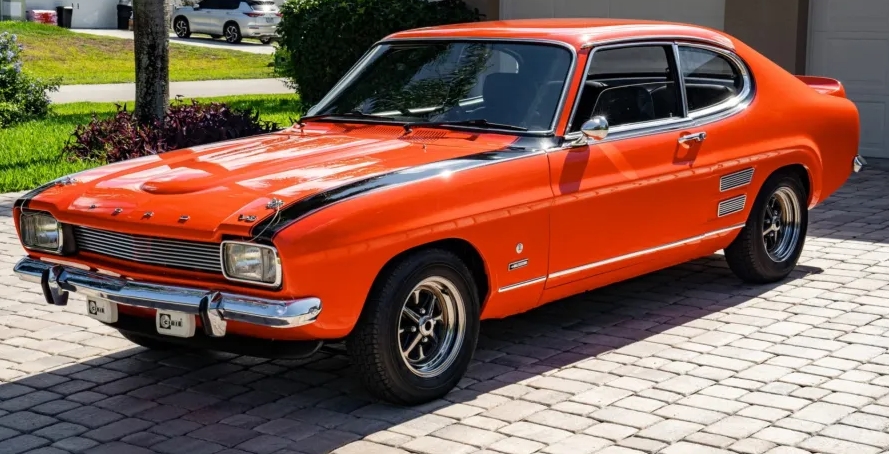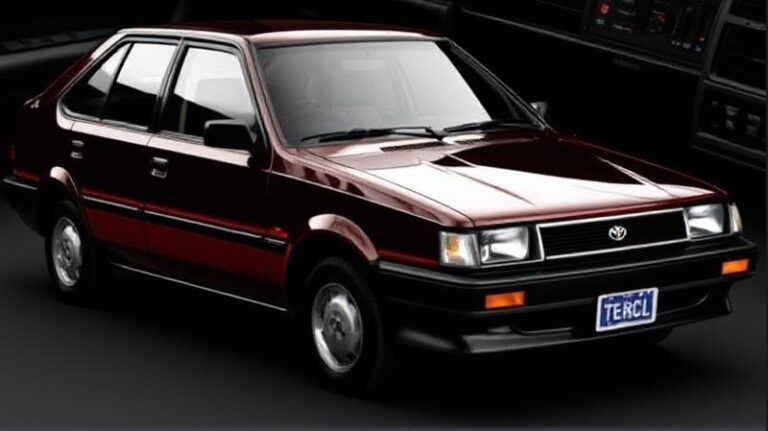The Car You Always Promised Yourself: The Evolution of the Ford Capri
In the landscape of automotive history, few cars captured the public’s imagination quite like the Ford Capri. It wasn’t a supercar, nor was it a technological trailblazer. Instead, its genius lay in its accessibility. Launched with the memorable slogan, “The Car You Always Promised Yourself,” the Capri offered the aspirational styling of an exotic sports car, built upon the reliable and affordable mechanicals of a family saloon. It was a formula that Ford of Europe perfected, creating a cultural icon that would evolve significantly over its 17-year production run, leaving an indelible mark on the motoring world.
The Capri’s story begins in the mid-1960s. Ford in America had struck gold with the Mustang, a stylish, sporty coupe based on the humble Falcon platform. Ford of Europe, a conglomerate of Ford of Britain and Ford of Germany, saw the potential for a similar “pony car” tailored to European tastes and roads. The project, codenamed “Colt,” was spearheaded by American designer Philip T. Clark, who, fittingly, had also played a key role in the Mustang’s design. The objective was clear: create a car that looked fast, was fun to drive, and could be bought by the average working person.
Mark I (1969 – 1974): The European Pony Car is Born
The Ford Capri was officially unveiled at the Brussels Motor Show in January 1969. The public reaction was immediate and overwhelmingly positive. Its design was a masterpiece of proportion: a long, sweeping bonnet, a short rear deck, a sleek fastback roofline, and signature “hockey stick” side moldings. It looked far more expensive than it was, perfectly embodying the spirit of the age.
The true innovation of the Mk I Capri lay in its marketing and customization. Ford offered a dizzying “menu” of engines, trim levels, and optional extras, allowing buyers to tailor a car to their exact desires and budget. This meant the Capri could be anything from a thrifty, stylish commuter to a powerful, V6-engined street racer.
UK Models and Trims (1969-1972):
- 1300 & 1300 GT: The entry point, using Ford’s Kent crossflow engine. The GT offered more power and sportier trim.
- 1600 & 1600 GT: The volume seller, providing a perfect balance of performance and economy.
- 2000 GT: This model used the compact and smooth Essex V4 engine, offering a step up in performance.
- 3000 GT: The king of the early range. It was fitted with the formidable 3.0-litre Essex V6, transforming the Capri into a genuine muscle car with a 0-60 mph time of around 8.5 seconds.
- 3000E: Introduced in 1970, the ‘E’ for Executive added luxury features like vinyl roofs, cloth upholstery, and a sunroof, creating the ultimate grand touring Capri.
Simultaneously, German-built Capris offered a different range of Ford Taunus engines, including 1.3, 1.5, and 1.7-litre V4s, and 2.0, 2.3, and 2.6-litre Cologne V6s. This pan-European approach cemented the Capri’s broad appeal.
The most sought-after Mk I models were the homologation specials built for motorsport. Germany produced the RS2600 in 1970, a lightweight, fuel-injected beast designed to dominate the European Touring Car Championship, which it did with great success. In response, Ford of Britain launched the RS3100 in 1973. With its carbureted 3.1-litre Essex V6, distinctive ducktail spoiler, and quad headlamps, it was a raw and potent machine. Only around 250 were ever made, making it a holy grail for collectors today.
In late 1972, the Capri received a facelift. The changes were subtle but effective: larger headlamps, revised grille, improved seats, and tweaks to the suspension. This updated model, often unofficially called the “Mk I½,” kept the car fresh until its first major redesign.
.
SEARCHING for those hard to find FORD manuals, guides & books?
This place has you covered! SEE All FORD Manuals From 1920 – 1989.
CHOOSE the year of your vehicle:

.
Mark II (1974 – 1978): A Nod to Practicality
The world had changed by the mid-1970s. The 1973 oil crisis made buyers more conscious of fuel economy and practicality. Ford astutely recognized this shift and engineered the Mk II Capri to be a more usable, everyday car without sacrificing its sporty image.
Launched in February 1974, the Mk II’s most significant change was the introduction of a hatchback rear door, replacing the small boot lid of the Mk I. This single feature transformed the Capri’s utility, making it a genuinely practical sports coupe. The styling was softened, with a shorter bonnet and a larger glasshouse that improved visibility and created a more spacious-feeling cabin.
The bewildering array of options from the Mk I was simplified into a more structured trim hierarchy:
- L (Luxury): The basic model, typically with the 1.3-litre engine.
- GL (Grand Luxury): The mid-range, offering better upholstery, more chrome, and a wider choice of engines (1.6 or 2.0-litre).
- S (Sport): The performance-oriented model, usually featuring the 2.0-litre Pinto or the 3.0-litre Essex V6. It came with stiffer suspension, alloy wheels (or styled steel wheels), and sporty decals.
- Ghia: Replacing the ‘E’ badge, Ghia became Ford’s top-tier luxury designation. The 2.0 and 3.0 Ghia models featured high-end interiors, vinyl roofs, and every conceivable extra.
One of the most iconic special editions of this era was the John Player Special (JPS) model from 1975. Dressed in the black-and-gold livery of the JPS-sponsored Lotus Formula 1 team, it was a cosmetic package available on 1.6, 2.0, and 3.0-litre models that became an instant classic.
While the Mk II was a more sensible and comfortable car, some enthusiasts felt it had lost some of the raw, aggressive edge of the original. Commercially, however, it was a success, proving that a sports car could also be practical.
Mark III (1978 – 1986): The Aggressive Finale
If the Mk II was a reaction to the oil crisis, the Mk III was a defiant return to form. Launched in March 1978, it wasn’t an all-new car but a major restyling of the Mk II platform. Ford’s engineers and designers focused on giving the Capri a more aggressive and aerodynamic appearance, positioning it squarely as a performance bargain in an era that would soon be dominated by the hot hatchback.
The Mk III’s styling is perhaps the most remembered today. It featured a distinctive front end with quad round headlamps and a “droop snoot” grille that sloped down over the bumper, reducing drag. The bonnet edge wrapped over the headlights, giving the car an intimidating glare. Black trim replaced much of the chrome, and S models featured a prominent rear spoiler.
The model lineup was once again rationalized, with a clear focus on performance:
- L, GL: Entry-level models, often with 1.6-litre engines.
- Ghia: The luxury flagship, available with the 2.0-litre Pinto or 3.0-litre V6.
- S (Sport): The heart and soul of the Mk III range. The 2.0 S and 3.0 S were the definitive models, instantly recognisable by their bold side stripes and distinctive interiors trimmed in “Carla” or “Sawtooth” chequered fabric.
The biggest evolution for the Mk III came in 1981. With the venerable Essex V6 engine nearing the end of its life, Ford introduced the Capri 2.8 Injection. This model used the German-built 2.8-litre Cologne V6, but with the crucial addition of Bosch K-Jetronic fuel injection. Power jumped to 160 bhp, the suspension was significantly revised by Ford’s Special Vehicle Engineering (SVE) department, and a five-speed gearbox was fitted. The 2.8i was a revelation, a fast, well-balanced, and modern-feeling machine that revitalized the Capri’s image and is widely considered the best-handling production Capri ever made.
As the Capri entered its twilight years, Ford released a series of desirable run-out models:
- Capri 2.8 Injection Special (1984): An upgraded 2.8i featuring a limited-slip differential, seven-spoke RS wheels, and a luxurious interior with half-leather Recaro seats.
- Tickford Turbo (1983): The ultimate factory-sanctioned Capri. Engineered by Aston Martin’s tuning arm, this machine featured a turbocharged 2.8-litre engine producing 205 bhp, a wild custom body kit, a lavish leather interior, and a price tag that put it in Porsche territory. It was rare, expensive, and incredibly fast.
- Capri 280 “Brooklands” (1986): The final swansong. The last 1,038 Capris produced were all 2.8i models, finished in a unique “Brooklands Green” paint with a full leather Recaro interior, a limited-slip differential, and 15-inch seven-spoke wheels. The final car rolled off the production line in Cologne, Germany, on 19th December 1986.
Legacy
By the end of its run, the Ford Capri platform was undeniably dated. The market had moved on, favoring front-wheel-drive hot hatchbacks like the Golf GTI and Ford’s own Escort XR3i. Yet, for nearly two decades, the Capri had offered something unique: rear-wheel-drive dynamics and movie-star looks for a fraction of the cost. It had been a rally car, a touring car champion, and a star of the screen in shows like The Professionals.
Across three distinct generations and millions of units sold, the Ford Capri evolved from a simple, stylish coupe into a practical hatchback, and finally into a focused, aggressive performance car. It perfectly captured the spirit of its time and delivered on its simple, brilliant promise. It was, and for a generation of enthusiasts, will always remain, the car they always promised themselves.







